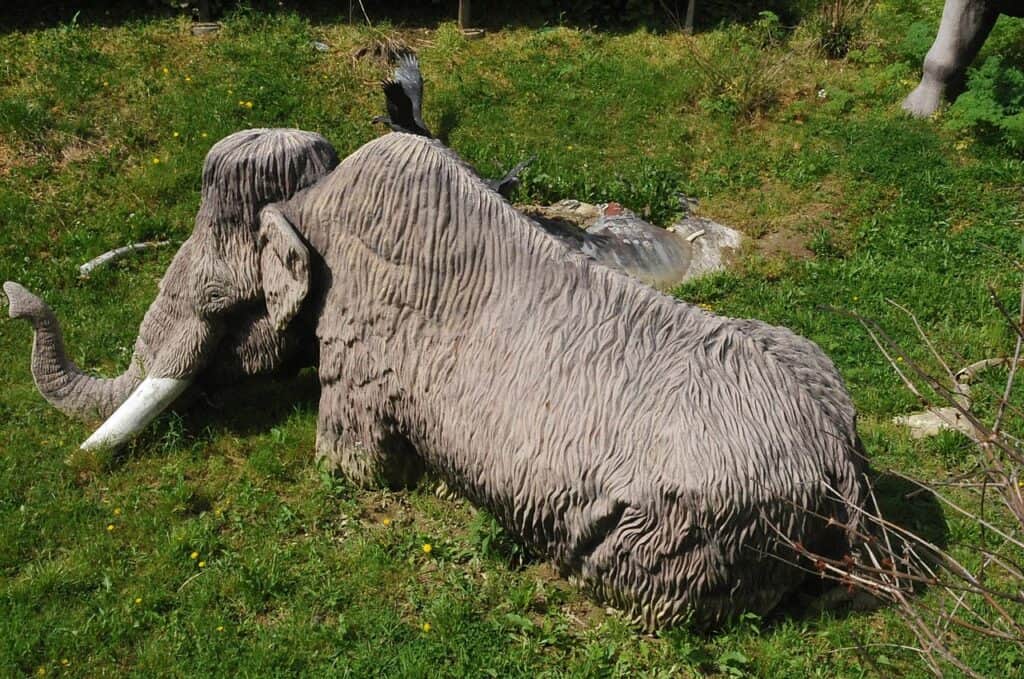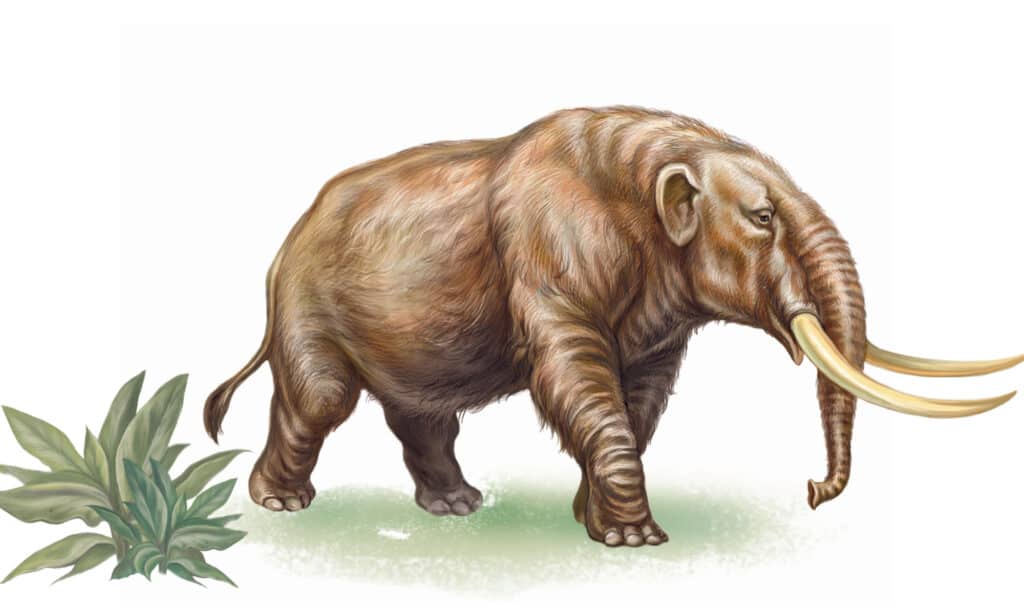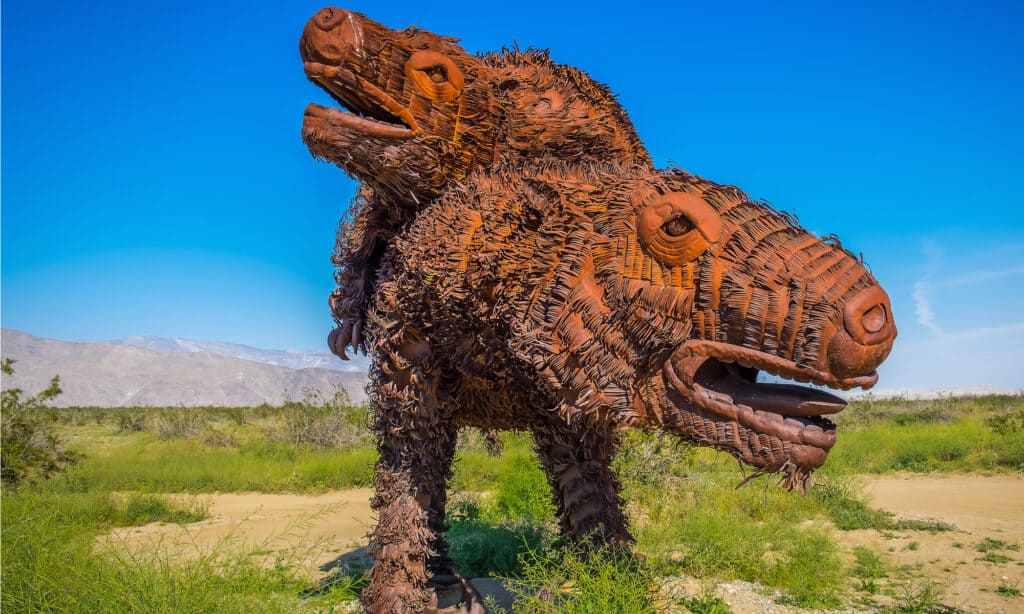Kentucky is home to one of the country’s most significant prehistoric fossil collections, as it hosts a site where numerous massive fossils were discovered.
First, when Kentucky was covered by water, it was abundant in aquatic species, such as brachiopods, crinoids, trilobites, and cephalopods. Many fossils found in Kentucky belonged to these marine animals, but only trilobites are now extinct.
The region is believed to have been uninhabited for a long time, as archeologists could only find plant fossils. While the state lacks evidence indicating that dinosaurs inhabited the area, there’s plenty of proof that animals such as mammoths and mastodons found their home in what we now call Kentucky.
Let’s first find out some details about the famous Big Bone Lick, then describe some prehistoric animals that lived in Kentucky.
What is Big Bone Lick Known For?

Big Bone Lick is one of the country’s most important and extensive fossil sites.
©Mattguyver / CC BY 3.0 – License
Big Bone Lick is one of the country’s most important and extensive fossil sites. It is located in Boone County. Prehistoric animals supposedly came here for the salt lick- a mineral nutrient deposit that animals could lick. Benjamin Franklin and Thomas Jefferson were only some of the significant historical individuals that came to study this salt lick. There’s a whole Iroquois tale that indicates how this site was discovered. Here’s how it goes.
Big Bone Lick History
When the Iroquois returned from battles, one got sick and had to be left on the road. Unwell and trying to recover, the warrior supposedly saw three “little people” in a canoe that came to kill some mysterious beasts living in a salt lick. It turned out that these creatures weren’t fantasy, as the man saw these three little people kill the monstrous animals.
After that, they helped him recover, so he returned to his village and told everyone what had happened. The villagers decided to check the salt lick, where they discovered gigantic animal bones.
What Fossils Were Found in Big Bone Lick?
There’s no evidence indicating that this story is or isn’t true. It’s certain that until now, numerous huge animal bones have been found on the site – thigh bones measuring 4-5 feet long, enormous skulls, and 7-8-foot-long tusks. These bones are believed to have belonged to mastodons, mammoths, and Arctic elephants. In 1868, archeologists discovered a “wagon load of bones of the Mammoth,” which included tusks as thick as 10 inches, a backbone, and a tooth weighing 20 pounds and measuring 15 inches long.
The Big Bone Lick is the only place where such a significant quantity of fossils have been found. It has been named “the graveyard of the Mammoth.” During the 1807 expedition by William Clark, the salt lick received the name “the birthplace of American paleontology.” This title has been used until the present day.
Big Bone Lick State Park

Big Bone Lick State Park is open to visitors, and its visitor centers opened in 2004.
©JERRYE & ROY KLOTZ MD / CC BY-SA 3.0 – License
Big Bone Lick State Park is open to visitors. Its visitor centers opened in 2004. They feature fossil exhibits, pieces of American art, and a gift shop. Tourists are attracted mainly by the 1,000-pound mastodon skull featured in the park.
Visitors will see recreations of a ground sloth, a woolly mammoth, and bison. If you want to learn more about the region’s history, you can stay the night at the 62-site campground provided by the park. Several trails in the park take you through wetlands, grasslands, and savannas. In a way, you’ll walk on the same land that prehistoric animals walked on.
In 2002, Big Bone Lick State Park became a Lewis and Clark Heritage Trail Site. In 2009, it received the status of being a National Natural Landmark.
4 Extinct Animals That Lived in Kentucky
1. Trilobite

There were over 20,000 different species of trilobites.
©SciePro/Shutterstock.com
| Trilobite | |
|---|---|
| Kingdom | Animalia |
| Phylum | Arthropoda |
| Clade | Arachnomorpha |
| Subphylum | Trilobitomorpha |
| Class | Trilobita |
| Living period | 521-252 million years ago |
Trilobites are extinct marine arthropods. There were over 20,000 different species of trilobites. Scientists believe these arthropods first appeared during the Early Cambrian period, approximately 521 million years ago. Supposedly, they lived for more than 260 million years, going extinct during the Permian period.
Trilobites inhabited Kentucky when the state was covered in water, alongside brachiopods, crinoids, and cephalopods. Unfortunately, only the trilobites have gone extinct.
Trilobite species found in the area include:
- Isotelus;
- Flexicalymene;
- Gravicalymene;
- Platylichar;
- Proetidella;
- Ceraurus;
- Arctinurus;
- Eomonorachus.
2. American Mastodon

The American mastodon is one of the species in the Mammut genus.
©Liliya Butenko/Shutterstock.com
| American mastodon | |
|---|---|
| Kingdom | Animalia |
| Phylum | Chordata |
| Class | Mammalia |
| Order | Proboscidea |
| Family | Mammutidae |
| Genus | Mammut |
| Species | Mammut americanum |
| Extinct since | 11,000 years ago |
The American mastodon is one of the species in the Mammut genus. Native Americans called it a “giant buffalo.” Supposedly, it appeared in the early-middle Pliocene. Scientists previously believed that the American mastodon had a similar appearance to that of the woolly mammoth. Later discoveries showed that, unlike the woolly mammoth, the American mastodon had no body hair and had a semi-aquatic lifestyle.
The American mastodon disappeared 11,000 years ago. Many mastodon fossils were discovered at Big Bone Lick in Kentucky.
3. Harlan’s Ground Sloth

Harlan’s ground sloth lived between the Pliocene and Pleistocene epochs.
©eric laudonien/Shutterstock.com
| Harlan’s Ground Sloth | |
|---|---|
| Kingdom | Animalia |
| Phylum | Chordata |
| Class | Mammalia |
| Order | Pilosa |
| Family | Mylodontidae |
| Genus | Paramylodon |
| Species | Paramylodon harlani |
| Living period | From Pliocene to Pleistocene epochs; went extinct 11,000 years ago. |
The scientific name for Harlan’s ground sloth is Paramylodon. It was a ground sloth endemic to the North American continent.
Richard Harlan was the first to discover a mandible and a clavicle belonging to a ground sloth. The discovery was made in 1831 in Kentucky. It was first called Megalonyx, but over the years, it ended up being called Paramylodon because scientists noticed that the mandible discovered by Harlan resembled the mandible of Mylodon darwinii.
Harlan’s ground sloth lived between the Pliocene and Pleistocene epochs and disappeared around 11,000 years ago.
4. Woodland Muskox

The scientific name for woodland muskox is
Bootherium.
©Daderot / public domain – License
| Woodland muskox | |
|---|---|
| Kingdom | Animalia |
| Phylum | Chordata |
| Class | Mammalia |
| Order | Artiodactyla |
| Family | Bovidae |
| Genus | Bootherium |
| Species | Bootherium bombifrons |
| Living period | From the middle to late Pleistocene; it disappeared approximately 11,000 years ago. |
Amelia Hulth, the Big Bone Lick park interpreter, states that fossils discovered in the salt lick also included woodland muskox.
The scientific name for woodland muskox, or, as some people call it, Harlan’s muskox, is Bootherium. It was distributed throughout the North American continent and lived from the middle to late Pleistocene. Other muskox species inhabiting the region during that era included tundra muskox, shrub-o, and Soergel’s ox. They all disappeared, except for the tundra muskox.
Summary of 4 Extinct Animals That Lived in Kentucky
| Rank | Species | Period of Existence |
|---|---|---|
| 1 | Trilobite | The Early Cambrian to the Permian |
| 2 | American Mastodon | The Pleistocene |
| 3 | Harlan’s Ground Sloth | From the Pliocene to the Pleistocene |
| 4 | Woodland Muskox | From the middle to the late Pleistocene |
The photo featured at the top of this post is © Liliya Butenko/Shutterstock.com
Thank you for reading! Have some feedback for us? Contact the AZ Animals editorial team.






